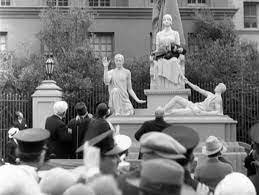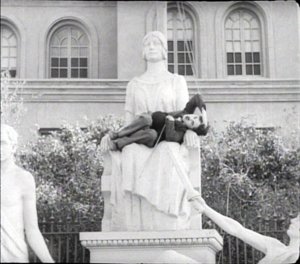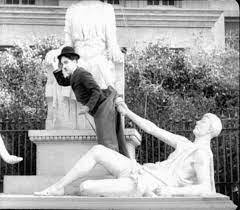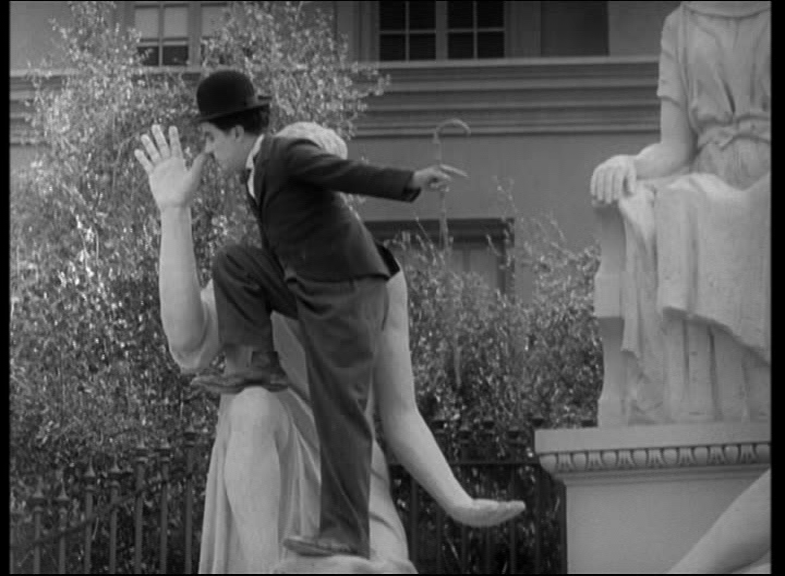THE LITTLE TRAMP AND HIS MASTERPIECE
LOS ANGELES, JANUARY 30, 1931 — Model Ts and trolleys scurry past L.A.’s new downtown theater. Crowds line sidewalks. Police keep order, but she crush of people shatters several windows. Then at dusk, the stars come out. Douglas Fairbanks and Mary Pickford. Gary Cooper and Gloria Swanson. And finally, the only star whose entrance brings the crowd to its feet — Albert Einstein. Behind him is his new friend, Charlie Chaplin.
Driving to the theater, Chaplin had shared his fears. “I don’t think it’s going to go over,” he told Einstein. “I don’t think they’re going to like it.”
By 1931, Chaplin had risen from an impoverished London boyhood to the heights of show business. His “little tramp” had charmed audiences around the world. He had dined with royalty (and with Einstein the night before.) He had made dozens of shorts plus three full-length comedies for the studio he co-founded - United Artists.
But the Twenties were over and Chaplin was in decline. His marriage to a 16-year-old led to outrage, and his divorce deepened the scandal. Now the Depression had America in its grip. And a new fad had come to the screen — sound.
Chaplin remembered first seeing a “talkie.” When a car door closed, “it sounded like the collision of two lumber trucks.” The days of sound “were numbered,” he thought. But by 1931, talking pictures had drowned the silent era. And now here was the bygone era’s genius bringing a Nickelodeon art form to a palatial theater. When Einstein tried to reassure him, Chaplin turned somber. “No,” he insisted, “I just feel it.”
The filming had dragged on. Nothing worked as planned. Actresses auditioning for the part of a blind girl could not feign blindness. When he finally found a woman who could “look inwardly and not see me,” she seemed “an amateur.” After weeks of shooting, he fired her and auditioned others. Then he took her back and started over.
But scene after scene was wrong. Minutes onscreen took weeks in the studio. For 9,000 feet of film, Chaplin shot 300,000. “I had worked myself into a neurotic state of wanting perfection,” he remembered.
Then in August 1928, Chaplin’s mother died. A minor British stage actress, she had raised her two sons alone, Chaplin’s drunken father having died when he was a boy. The day before her death, Chaplin sat with his mother in the hospital. Back on the set, he got the grim news. He rushed to his mother’s bed but “could not touch her. No, I could not touch her.” Nor could he continue work. Ptomaine poisoning and flu took another month out of his film, his life.
Divorced, estranged from his ex-wife and children, Chaplin lived alone. “The evening,” he said, “is a rather lonesome place.” Driving himself onward, he worked seven days a week.
Friends told him he had “a lot of courage” to stick with silents. And he was taking another bold step. Because sound had replaced silent film orchestras, he would not just write, direct, and act. He would compose his own music. “Make it funny,” producers said of the film score, but he refused. “I wanted the music to be a counterpoint of grace and charm.”
Finally, after three years in the making, opening night arrived. Chaplin sat beside Einstein, terrified. The camera opened on a city park and a mayor dedicating a cloth-draped statue. No words, just the man squawking like a human kazoo. The audience laughed. Then the cloth was lifted. Sleeping on the statue was the little tramp. The crowd cheered. Chaplin relaxed. “I had got them.”
For 90 minutes, some 2,000 people in the palatial theater bore witness to a masterpiece. A little tramp. A blind girl. A bittersweet story. The tramp learns of an operation to cure blindness, but it costs a fortune. He has befriended a millionaire, gone out dancing with him, but when sobered up, the man doesn’t remember him. So the tramp gets a job and tries everything to raise money for the girl, even boxing.
Shooting these scenes was torture, but Chaplin shot the final scene in an afternoon. “Sometimes it comes through with a great deal of that magic,” he remembered. “I’ve had that once or twice. . . standing outside myself and looking, studying her reactions and being slightly embarrassed about it. And it came off.”
Watching the audience watch, Chaplin knew. Even Einstein was wiping his eyes, “further evidence,” Chaplin thought, “that scientists are incurable sentimentalists.”
Chaplin soon premiered “City Lights” in New York and London. Critics praised it, though Variety noted “there is some doubt about its holdover power.”
“City Lights” went on to become Chaplin’s most acclaimed film. It remained the favorite of directors from Orson Welles to Stanley Kubrick. And that scene, that final scene, critic James Agee wrote, “is enough to shrivel your heart. . . the highest moment in movies.”















